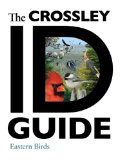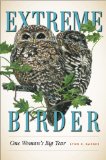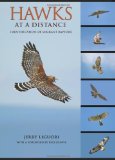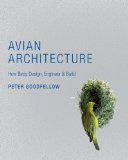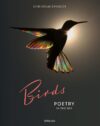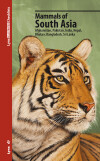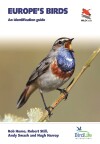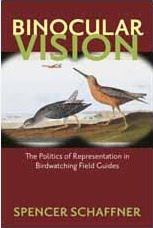 Binocular Vision: The Politics of Representation in Birdwatching Field Guides
Binocular Vision: The Politics of Representation in Birdwatching Field Guides
by Spencer Schaffner
From the publisher (University of Massachusetts Press):
From meadows to marshlands, seashores to suburbs, field guides help us identify many of the things we find outdoors: plants, insects, mammals, birds. In these texts, nature is typically represented, both in words and images, as ordered, clean, and untouched by human technology and development. This preoccupation with species identification, however, has produced an increasingly narrow view of nature, a “binocular vision,” that separates the study of individual elements from a range of larger, interconnected environmental issues. In this book, Spencer Schaffner reconsiders this approach to nature study by focusing on how birds are presented in field guides.
Starting with popular books from the late nineteenth century and moving ultimately to the electronic guides of the current day, Binocular Vision contextualizes birdwatching field guides historically, culturally, and in terms of a wide range of important environmental issues. Schaffner questions the assumptions found in field guides to tease out their ideological workings. He argues that the sanitized world represented in these guides misleads readers by omitting industrial landscapes and so-called nuisance birds, leaving users of the guides disconnected from environmental degradation and its impact on bird populations.
By putting field guides into direct conversation with concerns about species conservation, environmental management, the human alteration of the environment, and the problem of toxic pollution, Binocular Vision is a field guide to field guides that takes a novel perspective on how we think about and interact with the world around us.
I’m not sure I’m going to buy some of the author’s conclusions, but I suppose I should withhold judgment until I read more than the first chapter! Regardless, I have the feeling that I’ll never look at a field guide in the same way after I finish this book.

 Until September 5, 2011, the Audubon Birds mobile app for iPhone, Android, and Palm will be on sale for $4.99 (normally $14.99).
Until September 5, 2011, the Audubon Birds mobile app for iPhone, Android, and Palm will be on sale for $4.99 (normally $14.99).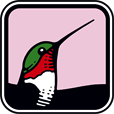 Appweavers has produced a nice app version of the Peterson field guide –
Appweavers has produced a nice app version of the Peterson field guide – 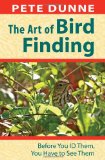 The Art of Bird Finding: Before You ID Them, You Have to See Them
The Art of Bird Finding: Before You ID Them, You Have to See Them Binocular Vision: The Politics of Representation in Birdwatching Field Guides
Binocular Vision: The Politics of Representation in Birdwatching Field Guides
